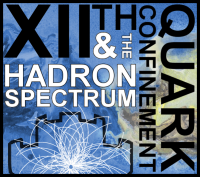Speaker
Description
The in-medium modification of hadron properties is the main field of study for the strangeness sector in the non-perturbative low-energy region of QCD.
The behaviour of strange hadrons at extreme densities are of capital importance for the description of the nuclear equation of state and the evaluation of the strangeness component in the core of the neutron stars.
The study of hyperon-nucleon(s) and hyperon-pion correlations following K$^-$ nuclear absorption in $^4$He and $^{12}$C were investigated with the KLOE drift chamber and the results will be presented. To this end, KLOE [1] data (from 2004-2005-2012) was analyzed using the detector itself as an active target.
The $\Sigma^0$p final state has been analyzed exclusively for the first time [2].
The results include yield per stopped kaon for the simplest two nucleon "quasi-free" absorption, ratios for the two-nucleon vs three-nucleon process, and a systematic search for a ppK$^-$ bound state.
The existence of such objects, whose experimental detection has been claimed several times recently, also in absorption experiments, would open the possibility for the formation of very dense baryonic matter implying a deep attractive value for the antikaon-nucleon potential.
The analysis of the $\Lambda(\Sigma^0)\pi$ channel from absorptions in $^4$He will be presented as well.
The data have been interpreted within a theoretical phenomenological model which allows to quantify the role played by the resonant $\Sigma$(1385) formation, allowing to extract the module of the non-resonant K$^−$n $\rightarrow \Lambda \pi$ amplitude (∼ 33 MeV/c$^2$ below threshold).
[1] F. Bossi et al. Riv. Nuovo Cimento 31 (2008) 10.
[2] O. Vazquez Doce et al., Physics Letters B 758 (2016) 134.
